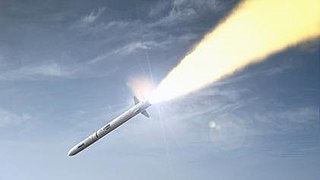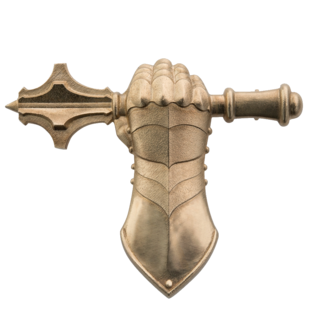
The Polish Air Force is the aerial warfare branch of the Polish Armed Forces. Until July 2004 it was officially known as Wojska Lotnicze i Obrony Powietrznej. In 2014 it consisted of roughly 26,000 military personnel and about 475 aircraft, distributed among ten bases throughout Poland.

The Land Forces are the land forces of the Polish Armed Forces. They currently contain some 110,000 active personnel and form many components of the European Union and NATO deployments around the world. Poland's recorded military history stretches back a millennium – since the 10th century. Poland's modern army was formed after Poland regained independence following World War I in 1918.

PZR Grom is a man-portable air-defense system produced in Poland and based on the Soviet man-portable infrared homing surface-to-air missile (SAM) 9K38 Igla. It consists of a 72 mm anti-aircraft missile set with a flight speed of 650 m/s, as well as a single-use launcher, re-usable gripstock and thermal battery coolant assembly electric unit. The full name of the system is Przeciwlotniczy Zestaw Rakietowy Grom.

Polish 1st Legions Infantry Division is a tactical formation of the Polish Army. Formed on February 20, 1919, partially of veterans of the I Brigade of the Polish Legions, the unit saw extensive action during the Polish-Soviet War and World War II. Regarded by the soldiers of the Wehrmacht as the Iron Division, it distinguished itself in the Invasion of Poland.

The 18th Infantry Division is a division of the Polish Armed Forces. The division was originally part of Polish Army during the interbellum period, which took part in the Polish September Campaign. Stationed in Łomża and commanded in 1939 by Colonel Stefan Kossecki, it was part of the Narew Independent Operational Group.

Mechanized Infantry Forces of Ukraine are the general basis and primary combat formations of the Ukrainian Ground Forces. They execute tasks of holding the occupied areas, lines and positions tasks of enemy's impacts repelling, of penetrating the enemy's defense lines, defeating the enemy forces, capturing the important areas, lines and objectives, Capture and expel enemy forces from territory and can operate in structure of marine and landing troops.

The CAMM is a family of surface-to-air missiles developed by MBDA UK for the United Kingdom. CAMM is derived from, and shares some common features and components with, the Advanced Short-Range Air-to-Air Missile (ASRAAM), but with updated electronics, a soft vertical launch system, and an active radar homing seeker. The CAMM family is in use by or on order for the armed forces of several countries.

Kormoran II - officially project 258, mine hunting type of vessels in building for the Polish Navy. The 2011 Defense Budget included a single vessel of this class. It was launched on 4 September 2015 and was predicted to enter service late 2016. Two more ships have been planned. Ships are built by Remontowa Shipbuilding Gdańsk and Naval Shipyard Gdynia consortium. It will be armed with a 35mm OSU-35K naval weapon station.

18th Reconnaissance Regiment is a unit of the Polish Land Forces and is based in Białystok. It was formed from the former 18th Territorial Defense Battalion, which in turn was the former 18th Mechanized Brigade. It is the most recently formed unit of the Polish army, and one of three reconnaissance regiments.
The full structure of the Polish Land Forces is:

The Armoured Troops are the armored corps of the Ukrainian Ground Forces, the main striking force of ground troops. They are used primarily in conjunction with mechanized forces in key areas and perform the following tasks:
The following is a hierarchical outline of the Czechoslovak People's Army at the end of the Cold War. It is intended to convey the connections and relationships between units and formations. At the end of the Cold War in 1989 the Czechoslovak People's Army structure was as follows.

The Leopard 2PL is a main battle tank used by the Polish Armed Forces, and is a modernized version of the older Leopard 2A4 tank, phased out by Germany and first acquired by Poland in the 2000s. The modernisation is currently being carried out in cooperation with Rheinmetall and the Polish Armaments Group.

The SPZR Poprad is a very short range air defense (VSHORAD) self-propelled anti-aircraft missile system, produced by PIT-Radwar S.A.

PSR-A Pilica is a Polish Very Short Range Air Defense (VSHORAD) anti-aircraft missile and artillery system.
Numbers shown near the framework agreements in italicsdo include equipment ordered in subsequent contracts, envisaged in the framework agreement.

The OSU-35K is a Polish naval remote weapon station and a close-in weapon system manufactured by PIT-Radwar. Armed with a 35 mm Oerlikon KDA autocannon, it is meant to defend surface combatants against various types of maneuvering aerial targets such as anti-ship missiles, unmanned aerial vehicles, conventional and rotary-wing aircraft, It can also engage surface and coastal targets. It is in service with the Polish Navy on the Kormoran II-class minehunters and is planned to equip the Wicher-class frigates.

ZDPSR Bystra – A deployable radar station manufactured by PIT-RADWAR S.A., installed on the Żubr-P armored vehicle. A three-coordinate station equipped with an active electronic scanning antenna (AESA). Used in short-range (SHORAD) and very short-range (VSHORAD) air defense systems. It has Counter Rocket, Artillery, and Mortar capabilities.















